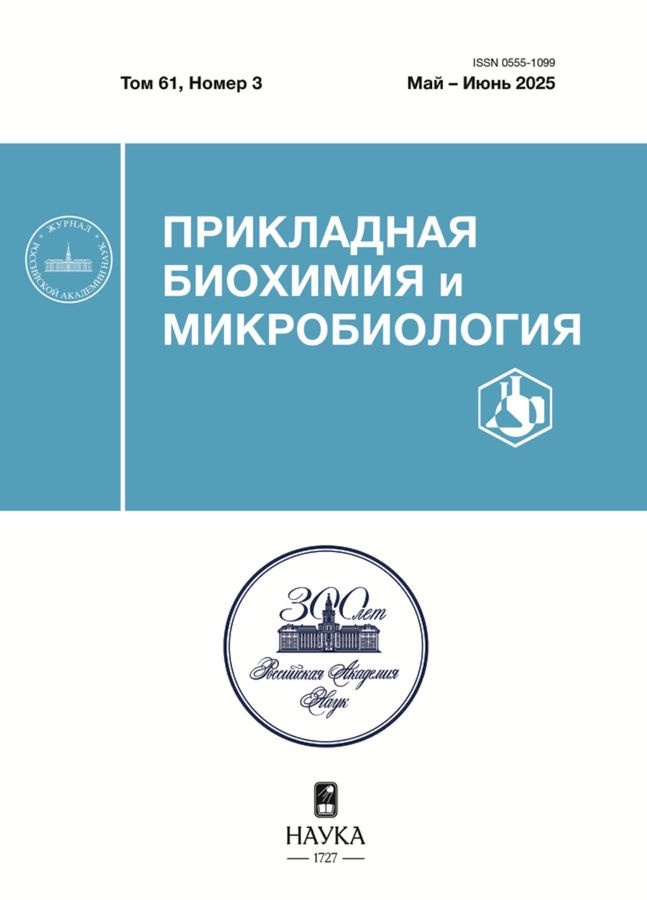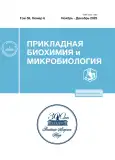Использование новых стратегий биоинформатики на этапе проектирования растений с редактированным геномом (обзор)
- Авторы: Яковлева И.В.1, Камионская А.М.1
-
Учреждения:
- Институт биоинженерии им. К.Г. Скрябина, Федеральное государственное учреждение “Федеральный исследовательский центр “Фундаментальные основы биотехнологии” Российской академии наук”
- Выпуск: Том 59, № 6 (2023)
- Страницы: 525-537
- Раздел: Статьи
- URL: https://gynecology.orscience.ru/0555-1099/article/view/674582
- DOI: https://doi.org/10.31857/S0555109923060211
- EDN: https://elibrary.ru/CYEAXH
- ID: 674582
Цитировать
Полный текст
Аннотация
Идентификация рисков, связанных с новыми сельскохозяйственными продуктами растительного происхождения, полученными технологией геномного редактирования, – важный компонент генной инженерии. Острая дискуссия продолжается во всем мире о сходстве и различиях между “старыми” рисками “классических” ГМО и “новыми”, связанными с геномным редактированием растений, отсутствием методов идентификации новых рисков и их оценки. В настоящей статье разрабатывается новый перспективный инструмент обеспечения биобезопасности – концепция “безопасного проектирования”, вводящая хорошо известные стандарты безопасности в биоинженерию растений. Суть этой стратегии состоит в проведении редизайна для последовательной минимизации или предотвращения рисков, а также нецелевых эффектов геномного редактирования на этапе концепта. Учитывая, что корреляция между предсказанными in silico и определенными экспериментально нецелевыми эффектами гРНК является основной проблемой, осложняющей применение системы CRISPR, большинство исследований сегодня сосредоточено на эффективности дизайна гРНК. Напротив, настоящая работа сфокусирована на биоинформатическом поиске и изучении потенциальных промоторов, рассматриваемых как источник потенциальных рисков в случае их нецелевого редактирования и соответствующего изменения транскрипционной активности. Эти стратегии представлены нами в виде схемы оценки рисков для целей регулирования новых генетических технологий.
Об авторах
И. В. Яковлева
Институт биоинженерии им. К.Г. Скрябина, Федеральное государственное учреждение“Федеральный исследовательский центр “Фундаментальные основы биотехнологии”
Российской академии наук”
Автор, ответственный за переписку.
Email: iacgea@biengi.ac.ru
Россия, 117312, Москва
А. М. Камионская
Институт биоинженерии им. К.Г. Скрябина, Федеральное государственное учреждение“Федеральный исследовательский центр “Фундаментальные основы биотехнологии”
Российской академии наук”
Email: iacgea@biengi.ac.ru
Россия, 117312, Москва
Список литературы
- Zhu Y. // Biomed Res. Int. 2022. 2022:9978571. https://doi.org/10.1155/2022/9978571
- Eriksson D., Custers R., Edvardsson Björnberg K., Hansson S.O., Purnhagen K., Qaim M. et al. // Trends Biotechnol. 2020. V. 38. P. 231–234. https://doi.org/10.1016/j.tibtech.2019.12.002
- Parrott W. // Physiol Plant. 2018. V. 164. № 4. P. 406-411. https://doi.org/10.1111/ppl.12756
- Yunzhen L., Wenhao Y. // Sci. China Life Sci. 2020. V. 63. № 9. P. 1406–1409. https://doi.org/10.1007/s11427-020-1693-4
- Korotkov E.V., Yakovleva I.V., Kamionskaya A.M. // Appl. Biochem. Microbiol. 2021b). V. 57. № 2. P. 271–279. https://doi.org/10.1134/S000368382102006X
- Konstantakos V., Nentidis A., Krithara A., Paliouras G. // Nucleic Acids Research. 2022. V. 50. № 7. P. 3616–3637. https://doi.org/10.1093/nar/gkac192
- Yan J., Chuai G., Zhou C., Zhu Ch., Yang J., Zhang Ch., Gu F., Xu H., et al. // Brief. Bioinformatics. 2018. V. 19. P. 721–724. https://doi.org/10.1093/bib/bbx001
- Modrzejewski D., Hartung F., Sprink T., Krause D., Kohl Ch., Wilhelm R. // Environ. Evid. 2019. V. 8. P. 27. https://doi.org/10.1186/s13750-019-0171-5
- Modrzejewski D., Hartung F., Lehnert H., Sprink T., Kohl C., Keilwagen J., Wilhelm R. // Front Plant Sci. 2020. V. 11. https://doi.org/10.3389/fpls.2020.574959
- MacLeod A., Spence N. // Emerg. Top Life Sci. 2020. V. 4. № 5. P. 449–452. https://doi.org/10.1042/ETLS20200343
- Hulme Ph.E. // BioScience. 2021. V. 71. № 7. P. 708–721. https://doi.org/10.1093/biosci/biab019
- UN News. https://news.un.org/en/story/2021/03/1087032
- CAST 2022. Council for Agricultural Science and Technology. https://www.cast-science.org
- Lassoued R., Macall D., Hesseln H., Phillips P.W.B., Smyth S.J. // Transgenic Res. 2019. V. 28. P. 247–256. https://doi.org/10.1007/s11248-019-00118-5
- Hua K., Zhang J., Botella J.R., Ma C., Kong F., Liu B., Zhu J.K. // Mol Plant. 2019. V. 12. № 8. P. 1047–1059. https://doi.org/10.1016/j.molp.2019.06.009
- Brende B. In The Global Risks Report 2020 World Economic Forum, Washington, USA, 2019, 15th Ed. Zeneva, Switzerland. P. 9–10.
- Bogner A., Torgersen H. // Policy. Front Plant Sci. 2018. V. 9. P. 1884. https://doi.org/10.3389/fpls.2018.01884
- Hellstrom T. // Technol. Soc. 2009. V. 31. P. 325–331. https://doi.org/10.1016/j.techsoc.2009.06.002
- Dragavtsev V. Academician Dragavtsev’s Protest Against the Presidium of the Russian Academy of Sciences “Give GMO Norms”. https://rossaprimavera.ru/article/04f0c499
- Fagan J., Antoniou M., Robinson Cl. // GMO Myths & Truths: A Citizen’s Guide to the Evidence on the Safety and Efficacy of Genetically Modified Crops and Foods. Earth Open Source. 2020.
- Chuchulina E.O. // Bulletin of Science. 2019. V. 4. № 6. P. 130–134.
- CBD 2012. Guidance on Risk Assessment of Living Modified Organisms. Convention on Biological Diversity. UNEP/CBD/BS/COP-MOP/6/13/Add.1; 2012. https://www.cbd.int/doc/meetings/bs/mop-06/official/mop-06-13-add1-en.pdf
- Guidelines for Assessing the Impact of Genetically Modified Organisms on the Environment and Health; In 2 Parts; 2005. Part 1. Introductory information, Accompanying Texts to Block Diagrams; ISEU: Moscow, Russia. 2005.
- European Commission 2001. Directive 2001/18/EC of The European Parliament and of the Council of 12 March 2001 on the Deliberate Release into the Environment of Genetically Modified Organisms. https://eur-lex.europa.eu/legal-content/EN/TXT/H-TML/?uri=CELEX:32001L0018&from=EN.
- GSO 2141:2011. 2011 General Requirements for Genetically Modified Unprocessed Agricultural Products. https://www.gso.org.sa/store/standards/GSO:563263/-GSO%202141:2011.
- Order of the Ministry of Agriculture of the Russian Federation On Approval of the Methodology for the Production of Examinations (studies) of Biological Safety of Genetically Engineered Plants for Growing (release into the environment) on the Territory of the Russian Federation. 2020. http://base.garant.ru/400229383/.
- USDA-Animal and Plant Health Inspection Service 2020. Fed. Regist. 85: 29790. https://www.govinfo.gov/content/pkg/FR-2020-05-18/html/2020-10638.htm.
- Lema M.A. // J. Regul. Sci. 2021. V. 9. № 1. P. 1–15. https://doi.org/10.21423/jrs-v09i1lema
- USDAa 2019. MAFF Guidance for the Handling of Genome Edited Organisms under the Cartagena Act. – https://apps.fas.usda.gov/newgainapi/api/Report/Down-loadReportByFileName?fileName=MAFF%20Guidance%20for%20the%20Handling%20of%20Genome%-20Edited%20Organisms%20under%20the%20Cartagena%20Act_Tokyo_Japan_11-15-2019.
- USDAb 2019. Final MAFF Guidelines for the Handling of Genome Edited Feed and Feed Additives. – https://apps.fas.usda.gov/newgainapi/api/Report/-DownloadReportByFileName?fileName=Final%-20MAFF%20Guidelines%20for%20the%20Handling%20of%20Genome%20Edited%20Feed%20and-%20Feed%20Additives%20_Tokyo_Japan_03-22-2020.
- USDAc 2019. Japan Modifies Handling Procedures for Genome Edited Foods. https://www.fas.usda.gov/data/japan-japan-modifies-handling-procedures-genome-edited-foods.
- Draft Federal Law № 134176-8. 2022. “On Amendments to the Federal Law “On State Regulation in the Sphere of Genetic Engineering Activities”. https://sozd.duma.gov.ru/bill/134176-8#bh_histras.
- Schiemann J., Robienski J., Schleissing S., Spök A., Sprink T., Wilhelm R.A. // Front. Plant Sci. 2020. V. 11. P. 284. https://doi.org/10.3389/fpls.2020.00284
- Globus R., Qimrom U. // Cell Biochem. J. 2018. V. 119. № 2. P. 1291–1298. https://doi.org/10.1002/jcb.26303
- Metje-Sprink J. // Front. Plant Sci. 2019. V. 9. P. 133–141. https://doi.org/10.3389/fpls.2018.01957
- Ahmad N., Rahman M., Mukhtar Z., Zafar Y., Zhang B. // J Cell Physiol. 2020. V. 235. № 2. P. 666–682. https://doi.org/10.1002/jcp.29052
- Sturme M.H.J., van Berg J.P., Bouwman L.M.S., De Schrijver A., de Maagd R.A., Kleter G.A., Battaglia-de Wilde E. // ACS Agric. Sci. Technol. 2022. V. 2. P. 192–201. https://doi.org/10.1021/acsagscitech.1c00270
- Chandrasekaran J., Brumin M., Wolf D., Leibman D., Klap C., Pearlsman M. et al. // Mol. Plant Pathol. 2016. V. 17. № 7. P. 1140–1153. https://doi.org/10.1111/mpp.12375
- Arndell T., Sharma N., Langridge P., Baumann U., Watson-Haigh N.S., Whitford R. // BMC Biotechnol. 2019. V. 19. № 1. P. 71. https://doi.org/10.1186/s12896-019-0565-z
- Walton R.T., Christie K.A., Whittaker M.N., Kleinstiver B.P. // Science. 2020. V. 368. P. 290–296. https://doi.org/10.1126/science.aba8853
- Murugan K., Seetharam A.S., Severin A.J., Sashital, D.G. // J. Biol. Chem. 2020. V. 295. № 17. P. 5538–5553. https://doi.org/10.1074/jbc.RA120.012933
- Hong Y., Meng J., He X., Zhang Y., Liu Y., Zhang C., Qi. H., Luan Y. // Phytopathology. 2021. V. 11. № 6. https://doi.org/10.1094/PHYTO-08-20-0360-R
- Malnoy M., Viola R., Junget M.-H., Koo O.J., Kim S., Kim J.S. et al. // Front. Plant Sci. 2016. V. 7. P. 1904. https://doi.org/10.3389/fpls.2016.01904
- Si X., Zhang H., Wang Y., Chen K., Gao C. // Nat. Protoc. 2020. V. 15. P. 338–363. https://doi.org/10.1038/s41596-019-0238-3
- Graham N., Patil G.B., Bubeck D.M., Dobert R.C., Glenn K.C., Gutsche A.T. et al. // Plant Physiol. 2020. V. 183. № 40. P. 1453–1471. https://doi.org/10.1104/pp.19.01194
- Hahn F., Nekrasov V. // Plant Cell Rep. 2019. V. 38. № 4. P. 437–441. https://doi.org/10.1007/s00299-018-2355-9
- Ahmad Sh., Wei X., Sheng Zh., Hu P., Tang Sh. // Brief Funct. Genomics. 2020. V. 19. № 01. P. 26–39. https://doi.org/10.1093/bfgp/elz041
- Faal G.P., Farsi M., Seifi A., Kakhki A.M. // Mol. Biol. Rep. 2020. V. 47. P. 3369–3376. https://doi.org/10.1007/s11033-020-05409-3
- Waterworth W.M., Drury G.E., Bray C.M., Westet Ch.E. // New Phytol. 2011. V. 192. P. 805–822. https://doi.org/10.1111/j.1469-8137.2011.03926.x
- O’Conner S., Li L. // Front. Plant Sci. 2020. V. 11. P. 600117. https://doi.org/10.3389/fpls.2020.600117
- Ellens K.W., Levac D., Pearson C., Savoie A., Strand N., Louter J., Tibelius C. // Transgenic Res. 2019. V. 28 (Suppl. 2). P. 165–168. https://doi.org/10.1007/s11248-019-00153-2
- Xu W., Fu W., Zhu P., Li Z., Wang C., Wang C. et al. // Int. J. Mol. Sci. 2019. V. 20. № 17. P. 4125. https://doi.org/10.3390/ijms20174125
- Weng M.L., Becker C., Hildebrandt J., Neumann M., Rutter M.T., Shaw R.G. et al. // Genetics. 2019. V. 211. № 2. P. 703–714. https://doi.org/10.1534/genetics.118.301721
- Young J., Zastrow-Hayes G., Deschamps S. et al. // Sci. Rep. 2019. V. 9. P. 6729.https://doi.org/10.1038/s41598-019-43141-6
- Tang X., Liu G., Zhou J., Ren Q., You Q., Tian L. et al. // Genome Biol. 2018. V. 19. P. 84.https://doi.org/10.1186/s13059-018-1458-5
- Li J., Manghwar H., Sun L., Wang P., Wang G., Sheng H. et al. // Plant Biotechnol J. 2019. V. 17. № 5. P. 858–868. https://doi.org/10.1111/pbi.13020
- Tsai H., Missirian V., Ngo K.J., Tran R.K., Chan S.R., Sundaresan V., Comai L. // Plant Physiol. 2013. V. 161. № 4. P. 1604–1614. https://doi.org/10.1104/pp.112.213256
- Song H., Park J.-I., Hwang B.-H., Yi H., Kim H., Hur Y. // Agronomy. 2020. V. 10. № 4. P. 602. https://doi.org/10.3390/agronomy10040602
- Korotkov E.V., Suvorova Y.M., Nezhdanova A.V., Gaidukova S.E., Yakovleva I.V., Kamionskaya A.M., Korotkova M.A. // Symmetry. 2021. V. 13. № 6. P. 917–937. https://doi.org/10.3390/sym13060917
- Suvorova Y.M., Kamionskaya A.M., Korotkov E.V. // BMC Bioinform. 2022. V. 22(1). P. 42. https://doi.org/10.1186/s12859-021-03977-0
- Korotkov E.V., Kamionskaya A.M., Suvorova Yu.M. // Biotechnologiya. 2020. V. 36. № 4. P. 15–20. https://doi.org/10.21519/0234-2758-2020-36-4-15-20
- Korotkova M.A., Kamionskya A.M., Korotkov E.V. In: Proceedings of the J. Physics: Conference Series; The VI Int. Conference on Laser&Plasma Researches and Technologies; LaPlas, USA; Moscow, Russia 2020. https://doi.org/10.1088/1742-6596/1686/1/012031
- Salieri B., Barruetabeña L., Rodríguez-Llopis I., Jacobsen N.R., Manier N., Trouiller B. et al. // NanoImpact. 2021. V. 23. https://doi.org/10.1016/j.impact.2021.100335
- EU-SAGE 2022. https://www.eu-sage.eu/genome-search
- Wolt J.D. // Prog. Mol. Biol. Transl. Sci. 2017. V. 149. P. 215–241. https://doi.org/10.1016/bs.pmbts
- Fister A.S., Landherr L., Maximova S.N., Guiltinan M.J. // Front Plant Sci. 2018. V. 9. P. 26. https://doi.org/10.3389/fpls.2018.00268
- Andres J., Blomeier T., Zurbriggen M.D. // Plant Physiol. 2019. V. 179. P. 862–884. https://doi.org/10.1104/pp.18.01362
- Hirsch C.D., Springer N.M. // Biochim. Biophys. Acta Gene Regul. Mech. 2017. V. 1860. P. 157–165. https://doi.org/10.1016/j.bbagrm.2016.05.010
- Philippines 2022. Memorandum Circular No. 8, Series of 2022. https://www.da.gov.ph/wp-content/uploads/2022/06/mc08_s2022_Revised.pdf.
- DBTt 2022. Guidelines for the Safety Assessment of Genome Edited Plants; Government of India, Ministry of Science& Technology, DBTt; 2022. https://dbtindia.gov.in/latest-announcement/guidelines-safety-assessment-genome-edited-plants 2022.
- Proposal for a Regulation on Plants Obtained by Certain new Genomic Techniques and their Food and Feed, and Amending Regulation (EU) 2017/625. https://www.europeansources.info/record/proposal-for-a-regulation-on-plants-obtained-by-certain-new-genomic-techniques-and-their-food-and-feed-and-amending-regulation-eu-2017-625/.
- Yakovleva I.V., Kamionskaya A.M. // Trends Biotechnol. 2022. V. 40. № 6. P. 635–638. https://doi.org/10.1016/j.tibtech.2021.12.004
- OGTR 2021. Department of Health of Australia. Overview – status of organisms modified using gene editing and other new technologies. https://www.ogtr.gov.au/resources/publications/overview-status-orga-nisms-modified-using-gene-editing-and-other-new-technologies.
- Health Canada 2022. Guidance on the Novelty Interpretation of Products of Plant Breeding, 2022. https://www.canada.ca/en/health-canada/services/-food-nutrition/legislation-guidelines/guidance-documents/guidelines-safety-assessment-novel-foods-derived-plants-microorganisms/guidelines-safety-asses-sment-novel-foods-2006.html#a5.
Дополнительные файлы








